Matrix metalloproteinase-9 (MMP9) is involved in the TNF-α-induced fusion of human M13SV1-Cre breast epithelial cells and human MDA-MB-435-pFDR1 cancer cells
- PMID: 29636110
- PMCID: PMC5894245
- DOI: 10.1186/s12964-018-0226-1
Matrix metalloproteinase-9 (MMP9) is involved in the TNF-α-induced fusion of human M13SV1-Cre breast epithelial cells and human MDA-MB-435-pFDR1 cancer cells
Abstract
Background: In addition to physiological events such as fertilisation, placentation, osteoclastogenesis, or tissue regeneration/wound healing, cell fusion is involved in pathophysiological conditions such as cancer. Cell fusion, which applies to both the proteins and conditions that induce the merging of two or more cells, is not a fully understood process. Inflammation/pro-inflammatory cytokines might be a positive trigger for cell fusion. Using a Cre-LoxP-based cell fusion assay we demonstrated that the fusion between human M13SV1-Cre breast epithelial cells and human MDA-MB-435-pFDR1 cancer cells was induced by the pro-inflammatory cytokine tumour necrosis factor-α (TNF-α).
Methods: The gene expression profile of the cells in the presence of TNF-α and under normoxic and hypoxic conditions was analysed by cDNA microarray analysis. cDNA microarray data were verified by qPCR, PCR, Western blot and zymography. Quantification of cell fusion events was determined by flow cytometry. Proteins of interest were either blocked or knocked-down using a specific inhibitor, siRNA or a blocking antibody.
Results: The data showed an up-regulation of various genes, including claudin-1 (CLDN1), ICAM1, CCL2 and MMP9 in M13SV1-Cre and/or MDA-MB-435-pFDR1 cells. Inhibition of these proteins using a blocking ICAM1 antibody, CLDN1 siRNA or an MMP9 inhibitor showed that only the blockage of MMP9 was correlated with a decreased fusion rate of the cells. Likewise, the tetracycline-based antibiotic minocycline, which exhibits anti-inflammatory properties, was also effective in both inhibiting the TNF-α-induced MMP9 expression in M13SV1-Cre cells and blocking the TNF-α-induced fusion frequency of human M13SV1-Cre breast epithelial cells and human MDA-MB-435-pFDR1 cancer cells.
Conclusions: The matrix metalloproteinase-9 (MMP9) is most likely involved in the TNF-α-mediated fusion of human M13SV1-Cre breast epithelial cells and human MDA-MB-435-pFDR1 cancer cells. Likewise, our data indicate that the tetracycline-based antibiotic minocycline might exhibit anti-fusogenic properties because it inhibits a cell fusion-related mechanism.
Keywords: Breast cancer; Cell fusion; MMP9; Minocycline; TNF-α.
Conflict of interest statement
Ethics approval and consent to participate
Not applicable.
Consent for publication
Not applicable.
Competing interests
The authors declare that they have no competing interests.
Publisher’s Note
Springer Nature remains neutral with regard to jurisdictional claims in published maps and institutional affiliations.
Figures
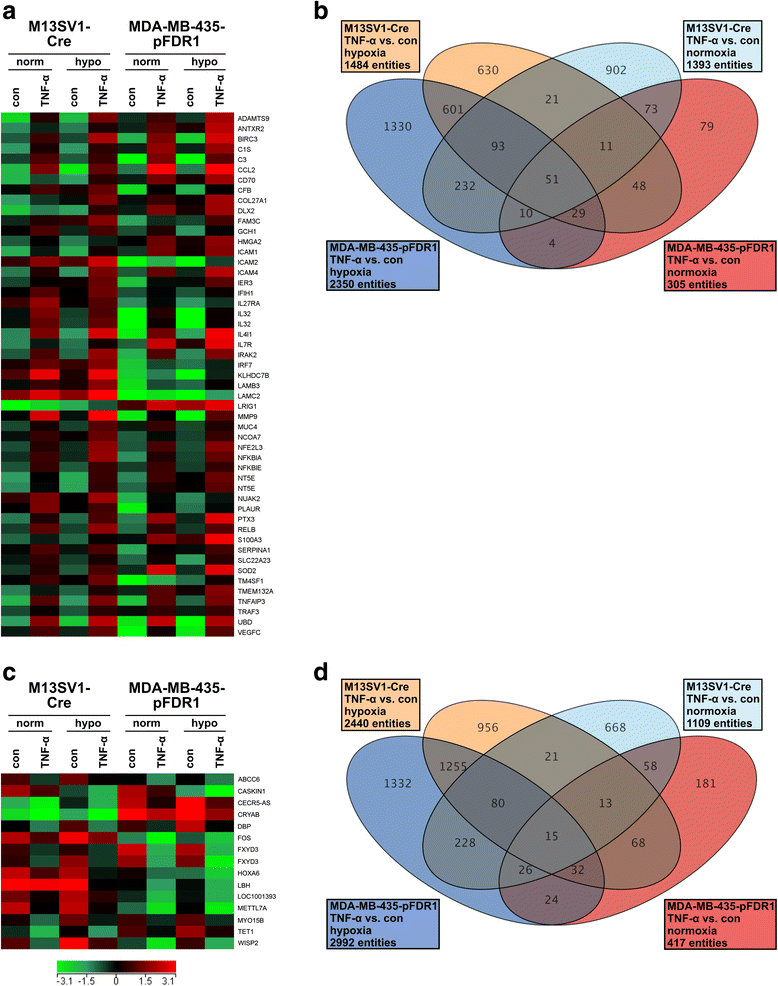
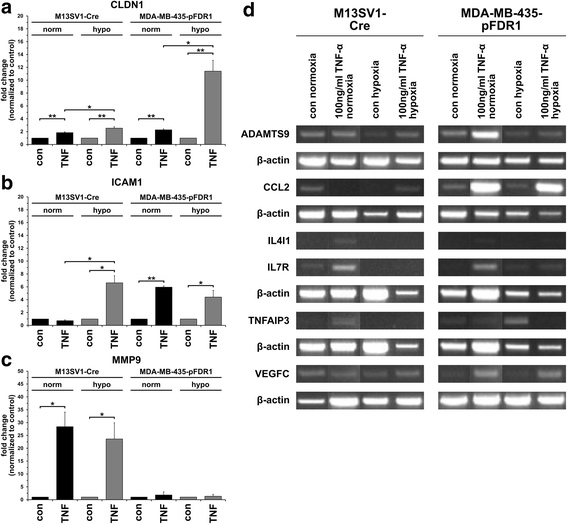
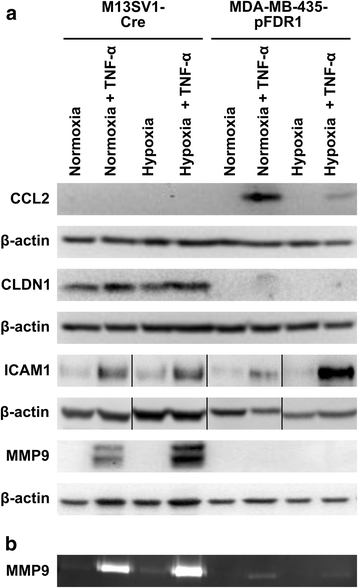
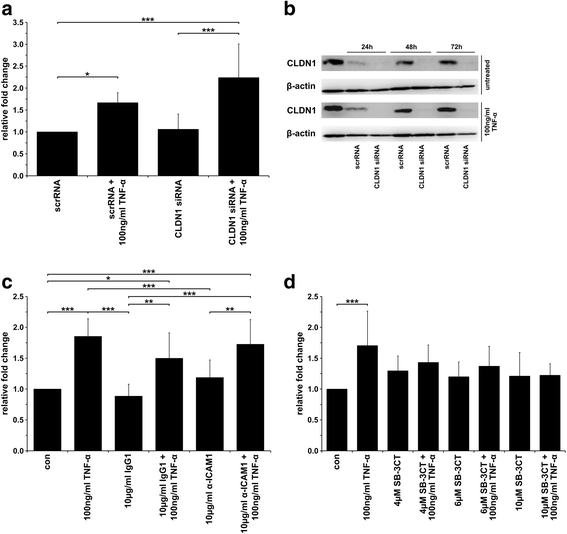
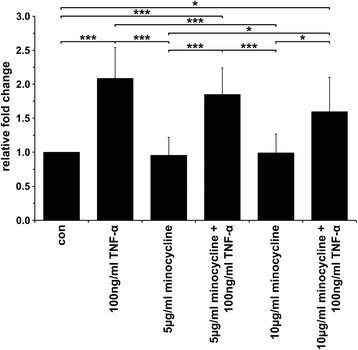
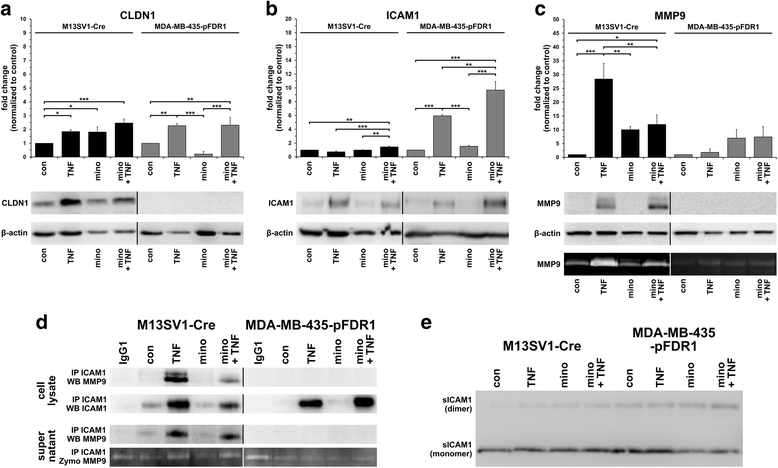
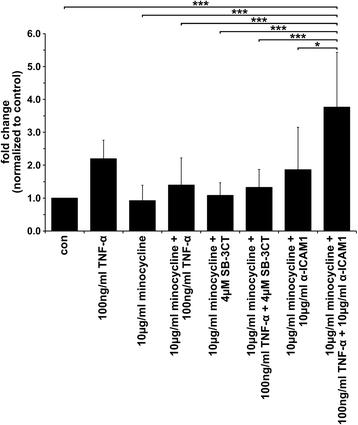
Similar articles
-
Minocycline impairs TNF-α-induced cell fusion of M13SV1-Cre cells with MDA-MB-435-pFDR1 cells by suppressing NF-κB transcriptional activity and its induction of target-gene expression of fusion-relevant factors.Cell Commun Signal. 2019 Jul 2;17(1):71. doi: 10.1186/s12964-019-0384-9. Cell Commun Signal. 2019. PMID: 31266502 Free PMC article.
-
Quantification of cell fusion events human breast cancer cells and breast epithelial cells using a Cre-LoxP-based double fluorescence reporter system.Cell Mol Life Sci. 2015 Oct;72(19):3769-82. doi: 10.1007/s00018-015-1910-6. Epub 2015 Apr 22. Cell Mol Life Sci. 2015. PMID: 25900663 Free PMC article.
-
Differential effects of minocycline on human breast epithelial cells, human breast cancer cells and their tumor hybrids.Mol Biol Rep. 2025 Jun 5;52(1):553. doi: 10.1007/s11033-025-10666-1. Mol Biol Rep. 2025. PMID: 40471394 Free PMC article.
-
Cell Fusion and Syncytia Formation in Cancer.Results Probl Cell Differ. 2024;71:433-465. doi: 10.1007/978-3-031-37936-9_20. Results Probl Cell Differ. 2024. PMID: 37996689 Review.
-
MMP9: A Tough Target for Targeted Therapy for Cancer.Cancers (Basel). 2022 Apr 6;14(7):1847. doi: 10.3390/cancers14071847. Cancers (Basel). 2022. PMID: 35406619 Free PMC article. Review.
Cited by
-
Cell Fusion in Human Cancer: The Dark Matter Hypothesis.Cells. 2019 Feb 7;8(2):132. doi: 10.3390/cells8020132. Cells. 2019. PMID: 30736482 Free PMC article. Review.
-
The Role of Mesenchymal Stem Cells in Modulating the Breast Cancer Microenvironment.Cell Transplant. 2023 Jan-Dec;32:9636897231220073. doi: 10.1177/09636897231220073. Cell Transplant. 2023. PMID: 38135917 Free PMC article. Review.
-
Mechanisms of Cell Fusion in Cancer.Results Probl Cell Differ. 2024;71:407-432. doi: 10.1007/978-3-031-37936-9_19. Results Probl Cell Differ. 2024. PMID: 37996688 Free PMC article. Review.
-
Clustered regularly interspaced short palindromic repeats (CRISPR)-Cas9 transfection of guide RNA targeting on MMP9 as anti-cancer therapy in human cutaneous squamous cell carcinoma cell line A431.Contemp Oncol (Pozn). 2023;27(4):255-262. doi: 10.5114/wo.2023.135364. Epub 2024 Feb 21. Contemp Oncol (Pozn). 2023. PMID: 38405210 Free PMC article.
-
Cell Fusion-Mediated Tissue Regeneration as an Inducer of Polyploidy and Aneuploidy.Int J Mol Sci. 2020 Mar 6;21(5):1811. doi: 10.3390/ijms21051811. Int J Mol Sci. 2020. PMID: 32155721 Free PMC article. Review.
References
Publication types
MeSH terms
Substances
LinkOut - more resources
Full Text Sources
Other Literature Sources
Research Materials
Miscellaneous

